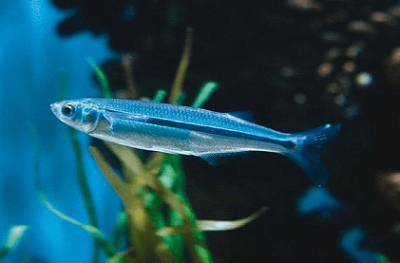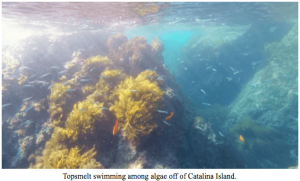
Snorkeling in the ocean is one of the most rewarding activities students engage in at CIMI. Jumping into the ocean to snorkel at night is a different experience altogether. Topsmelt earn their CIMI nickname, “giggle fish,” by helping students adjust to darkness through the element of surprise. This species lacks a lateral line, a common sensory system in bony fish used to detect changes in water pressure. Although topsmelt swim well in the daytime, they often smack into the unsuspecting bellies of nervous snorkelers at night, resulting in students giggling with amazement and relief.
Topsmelt (Atherinops affinis) are an elongate schooling fish that join jacksmelt and California grunion in a family commonly known as “silversides”. Topsmelt are also lumped in the colloquial group “baitfish,” because of their physical and behavioral likeness to other silver schooling fish that are commonly used as bait by fishermen. It has been argued that topsmelt are split into as many as five subspecies, but this has been refuted in recent years thanks to genetic analyses. Unlike true smelts however, silversides do not swim in tight balls when they school because they use sight instead of water pressure to sense where other fish move. As their name suggests, topsmelt prefer to live near the top of the water column in order to feed on algae and zooplankton, small animals that drift with the ocean’s currents. Many topsmelt are opportunistic feeders, with some populations in southern Baja California preferring to feed on parasitic Grey Whale lice! They have two peak spawning periods in May and June and often spawn at night during a full or new moon.
 This species is one of the most environmentally tolerant fish in the ocean. Topsmelt have been found from British Columbia, Canada through southern Baja California, Mexico in freshwater bays, brackish estuaries, kelp forests, piers, and offshore blue waters. They also thrive in evaporating salt ponds where the salinity is almost three times that of average seawater! Whereas most fish can only live in a narrow temperature range, the waters topsmelt live in range from 8 – 33ºC (46 – 91ºF). Topsmelt defy challenging conditions to reach a modest 14 cm in length and have a lifespan of 6 – 9 years. Their adaptability has made them a major player in eastern Pacific marine food webs.
This species is one of the most environmentally tolerant fish in the ocean. Topsmelt have been found from British Columbia, Canada through southern Baja California, Mexico in freshwater bays, brackish estuaries, kelp forests, piers, and offshore blue waters. They also thrive in evaporating salt ponds where the salinity is almost three times that of average seawater! Whereas most fish can only live in a narrow temperature range, the waters topsmelt live in range from 8 – 33ºC (46 – 91ºF). Topsmelt defy challenging conditions to reach a modest 14 cm in length and have a lifespan of 6 – 9 years. Their adaptability has made them a major player in eastern Pacific marine food webs.
 Topsmelt have many defense mechanisms that protect them from a long list of predators (leopard sharks, cormorants, harbor seals, and many more). First, their slender body shape and forked tail make them an ideal endurance swimmer with the capacity for sprint bursts if distressed. Topsmelt can even be seen leaping from the water around sunrise and sunset when pursued by predators! Countershading, or light camouflage, allows topsmelt to blend into natural light patterns in the ocean. The contrast between darker blue/green dorsal scales and silver ventral scales allows the fish to hide in the ocean itself instead of using a physical barrier. An observer looking at a topsmelt would have difficulty picking out an individual fish from the darker ocean depths or brighter ocean surface because of countershading.
Topsmelt have many defense mechanisms that protect them from a long list of predators (leopard sharks, cormorants, harbor seals, and many more). First, their slender body shape and forked tail make them an ideal endurance swimmer with the capacity for sprint bursts if distressed. Topsmelt can even be seen leaping from the water around sunrise and sunset when pursued by predators! Countershading, or light camouflage, allows topsmelt to blend into natural light patterns in the ocean. The contrast between darker blue/green dorsal scales and silver ventral scales allows the fish to hide in the ocean itself instead of using a physical barrier. An observer looking at a topsmelt would have difficulty picking out an individual fish from the darker ocean depths or brighter ocean surface because of countershading.
Like other baitfish, topsmelt use schooling behavior to create a large silver ball that distracts and confuses predators. It becomes difficult for a predator to pick out a single animal for a meal when fish swim close together and frequently change directions as a group. Schooling topsmelt take turns rotating between the outside and inside of the ball so that every animal has the same probability of relative safety and exposure. Topsmelt also use their silver scales to reflect light like a mirror back at predators. This behavior can stun predators and make a school of fish appear larger than what they really are—a collection of small animals.
Topsmelt populations are thriving in our changing oceans and are categorized as “Least Concern” on the IUCN Red List. They are not a popular commercial fishery despite a small following of fisherman who prefer to use topsmelt over other baitfish like sardines or anchovies. Their incredible tolerance for temperature and salinity variation distinguishes them from other fish that can only live in a narrow range of environmental conditions. However, the preferred food sources that topsmelt consume and the habitats that topsmelt use to lay eggs and raise their young are not as tolerant. With oceans becoming hotter and more acidic, it is unclear how the topsmelt will be impacted in future years. Topsmelt are also threatened by bioaccumulation, the process of building up toxins through consumption of primary producers. Eventually, the effects of toxins become magnified relative to the animal’s mass and can have negative impact on juvenile development or metabolic functions. The topsmelt’s wide distribution and environmental adaptability make them a key species for scientists to check on habitat healthiness.
To learn more about topsmelt, check out this link below:
http://www.aquariumofpacific.org/onlinelearningcenter/species/topsmelt
To see how topsmelt are different from other popular baitfish, follow this link:
http://data.recfin.org/wiki/index.php/Smelt_and_Baitfish
Written By: Alyssa Bjorkquist


